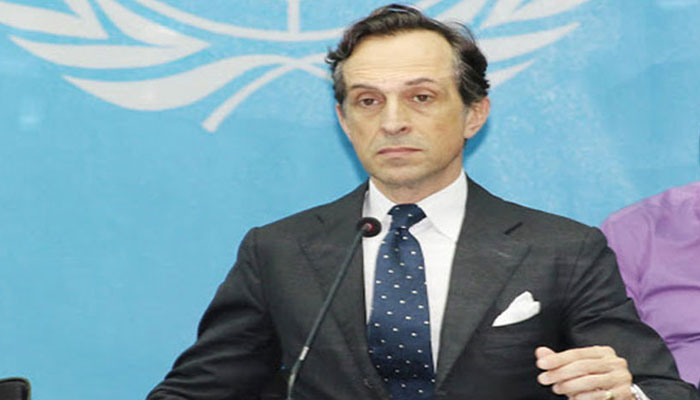UN revises appeal for Pak flood victims to $816m
The United Nations has revised the ‘Flash Appeal’ for Pakistan’s flood victims from $160 million to $ 816 million equaling to Rs186.12 billion
ISLAMABAD/ SEHWAN: Amid the second phase of death and disaster, the United Nations has revised the ‘Flash Appeal’ for Pakistan’s flood victims from $160 million to $ 816 million equaling to Rs186.12 billion.
The UN decided to upscale the humanitarian aid given the dismal health conditions in the flood-ravaged areas amid fast spreading waterborne diseases such as malaria, dengue and diarrhea.
Julien Harneis, UN Resident Coordinator in Pakistan, warned that the prevailing wave of diseases in the flood-ravaged areas could inflict many more deaths among flood victims particularly the children who are the most vulnerable segment.
Meanwhile, the emergency ward at the main government hospital in Sehwan, a small town in southern Pakistan, is overwhelmed. Hundreds of people crammed into rooms and corridors, desperately seeking treatment for malaria and other illnesses that are spreading fast after the country’s worst floods in decades.
Amid the crush, Naveed Ahmed, a young doctor in the emergency response department of the Abdullah Shah Institute of Health Sciences, is surrounded by five or six people trying to get his attention.
The 30-year-old keeps his cool as stretched emergency services struggle to cope with thousands of patients arriving from miles around after their homes were submerged under water when heavy rains fell in August and September.
“We become so overworked at times that I feel like collapsing and going on an intravenous drip,” a smiling Ahmed told as he sipped a cup of tea in the hospital’s canteen during a short break. “But it’s because of the prayers of these patients that we keep going.”
Ahmed is on the frontline of the battle to limit sickness and death across southern Pakistan, where hundreds of towns and villages were cut off by rising waters. The deluge has affected around 33 million people in a country of 220 million.
Most of the estimated 300-400 patients arriving at his clinic each morning, many of them children, are suffering from malaria and diarrhoea, although with winter approaching, Ahmed fears other illnesses will become more common.
“I hope people displaced by the floods can get back to their homes before winter; (if not) they will be exposed to respiratory illnesses and pneumonia living in tents,” he said. Hundreds of thousands of Pakistanis who fled their homes are living in government camps set up to accommodate them, or simply out in the open.
Stagnant floodwaters, spread over hundreds of square kilometres (miles), may take two to six months to recede in some places, and have already led to widespread cases of skin and eye infections, diarrhoea, malaria, typhoid and dengue fever.
The crisis hits Pakistan at a particularly bad time. With its economy in crisis, propped up by loans from the International Monetary Fund, it does not have the resources to cope with the longer term effects of the flooding.
Nearly 1,700 people have been killed in the floods caused by heavy monsoon rains and melting glaciers. Pakistan estimates the cost of the damage at $30 billion, and the government and United Nations have blamed the catastrophe on climate change.
Over 340 people have died of diseases caused by the floods, authorities have said. According to the health department of Sindh province, the worst-affected region, 17,285 cases of malaria have been confirmed since July 1.
Anticipating the risk of disease outbreaks after the rescue and relief phase of the floods, the Sindh government is trying to hire more than 5,000 health professionals on a temporary basis in districts most at risk.
“We are short of human resources considering the magnitude of the burden of disease following the unprecedented rains and floods,” Qasim Soomro, provincial lawmaker and parliamentary health secretary of the Sindh government, told.
The World Health Organization (WHO) has raised concern about an impending “second disaster” of water-borne diseases spreading across the country, particularly in Sindh.
In the hospital ward in Sehwan, a young man with a high fever was having fits on a bed outside the main emergency room. His mother ran to Ahmed, who attended the patient and asked a male nurse to place cold pads on his forehead.
The air was heavy with humidity, and there were not enough air conditioners to cool temperatures in overcrowded corridors lined with beds. The wards were filled to capacity and a handful of beds had more than one patient on them.
Ahmed, a graduate of a university in China, described the pressure he and other medics were under. “With such influx, we ... cannot wait for test results for each patient to start the treatment,” he said, adding he begins administering medicine for malaria as soon as he sees some symptoms.
The institute in Sehwan serves people from neighbouring towns and districts, including those living in camps while the waters recede and rebuilding can begin. Jagan Shahani’s daughter fell unconscious after getting a fever around a week ago. He used a boat to get out of his flooded village of Bhajara and flagged down a car on the nearby road that took them to Sehwan.
“Doctors said she had malaria,” he said, adding, “This is our fourth night here. There is nothing here to eat but Allah has been very kind to provide everything. On the outskirts of town, hundreds of displaced people queued up for rations being distributed at Lal Bagah, a tent settlement where displaced families prepared tea and breakfast on open fires.
The Indus Highway that runs past Sehwan is dotted with tent camps for displaced people. Some are beginning to return home where waters have retreated far enough, but not all are so lucky.
“There is no one here to help me but Allah. I pray to Allah that the waters recede in my village and I can return to my home,” said Madad Ali Bozdar. Bozdar, 52, is from Bubak, a town located on the north-eastern bank of Manchar Lake. He said his village is still under water. He expected to be able to go back in around two months’ time.
Besides, the Government of Pakistan and the United Nations are set to launch an up-scaled “flash appeal” today in Geneva on the basis of an updated on-ground needs assessment of the floods situation in the country.
Ministerial level participation from the government of Pakistan will include Minister for Climate Change Senator Sherry Rehman, attending the event in person in Geneva, and Minister for Planning, Development and Special Initiatives Ahsan Iqbal, Minister for Economic Affairs Sardar Ayaz Sadiq, and Minister of State for Foreign Affairs Hina Rabbani Khar participating virtually from Islamabad.
UN Under-Secretary-General for Humanitarian Affairs and Emergency Relief Coordinator Martin Griffiths and Director General WHO Dr Tedros Adhanom Ghebreyesus will represent the UN, along with Resident Coordinator in Pakistan Julien Harneis.
The meeting will be attended by the United States Member States as well as various UN agencies and humanitarian organizations working in the area of disaster relief.
The Floods Response Plan has been prepared in close coordination between the government of Pakistan and the United Nations, and focuses on providing necessary assistance to the vulnerable people affected by the unprecedented floods. It complements the government’s overall response to the recent climate-induced floods in Pakistan.
-
 Rachel McAdams Becomes Object Of Jokes At Hollywood Star Of Fame Event
Rachel McAdams Becomes Object Of Jokes At Hollywood Star Of Fame Event -
 South Korea's Ex-PM Han Duck-soo Jailed For 23 Years Over Martial Law Crises
South Korea's Ex-PM Han Duck-soo Jailed For 23 Years Over Martial Law Crises -
 Global Markets On Edge Over Greenland Dispute: Is US Economic Leadership At Risk?
Global Markets On Edge Over Greenland Dispute: Is US Economic Leadership At Risk? -
 King, Queen Visit Deadly Train Crash Site
King, Queen Visit Deadly Train Crash Site -
 Oxford Research Warns ChatGPT Reflects Western Worldviews
Oxford Research Warns ChatGPT Reflects Western Worldviews -
 UK Inflation Unexpectedly Rises To 3.4% In December, The First Increase In Five Months
UK Inflation Unexpectedly Rises To 3.4% In December, The First Increase In Five Months -
 Meghan Markle Set To Take Big Decision On Returning To UK For Invictus Games
Meghan Markle Set To Take Big Decision On Returning To UK For Invictus Games -
 Prince Harry To Leave Britain One Day Earlier Than Expected For THIS Reason
Prince Harry To Leave Britain One Day Earlier Than Expected For THIS Reason -
 The Way You Consume Sugar Could Be Affecting Your Health
The Way You Consume Sugar Could Be Affecting Your Health -
 Brooklyn Beckham Gets Backing From Vanessa Marcil Amid Feud With Parents
Brooklyn Beckham Gets Backing From Vanessa Marcil Amid Feud With Parents -
 OpenAI Uses AI To Detect Under 18 Users On ChatGPT
OpenAI Uses AI To Detect Under 18 Users On ChatGPT -
 Philippines To Lift Ban On Grok AI After Musk's Platform Commits To Fix Safety Concerns
Philippines To Lift Ban On Grok AI After Musk's Platform Commits To Fix Safety Concerns -
 Trump Vows ‘no Going Back’ On Greenland Ahead Of Davos Visit
Trump Vows ‘no Going Back’ On Greenland Ahead Of Davos Visit -
 Alexander Skarsgard Breaks Silence On Rumors He Is Bisexual
Alexander Skarsgard Breaks Silence On Rumors He Is Bisexual -
 King Charles Faces Rift With Prince William Over Prince Harry’s Invictus Games
King Charles Faces Rift With Prince William Over Prince Harry’s Invictus Games -
 Elon Musk’s Critique On ChatGPT Safety Draws Sharp Response From Sam Altman
Elon Musk’s Critique On ChatGPT Safety Draws Sharp Response From Sam Altman




